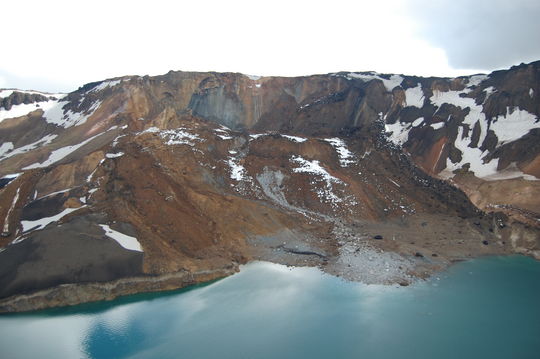Landslides
Landslides
Rockslide in the Askja crater, 21st July, 2014. Photo: Sveinn Brynjólfsson.
The term landslide is defined as mass wasting or movements of rock, debris or earth down a slope. This transportation occurs for various reasons but is often a combination of several factors; e.g. water flow due to heavy rainfall and snow melt, freeze and thaw cycles, increased volcanic activity, earthquakes, fault movements and etc. Landslides that occur in volcanic environment can vary in size from 0.1 km3 up to more than 100 km3.
Potential causes of landslides in volcanic environment:
- Magma intrusion in the volcano
- Phreatic eruption
- Earthquake or an earthquake swarm beneath or close to the volcano
- Heavy precipitation over long periods of time or short intense precipitation that saturates the soil, pyroclastic material or tephra
- Geothermal alterations due to long term activity or temporal increase
Landslides also occur at central volcanoes without any volcanic trigger. An example of this is the rockslide in Askja in 2014 where long term subsidence of a caldera wall, formed in volcanic activity in 1875, caused the slope instability. The slide is considered to be one of the biggest rock slides event in Iceland during historical times.
More about this landslide in Icelandic can be found here:
http://en.vedur.is/about-imo/news/nr/2930
http://en.vedur.is/avalanches/articles/nr/2929
Lahars
Lahars are a very specific type of landslides. They contain volcanic material (i.e. tephra, soil and rocks) mixed with water and occur in close vicinity of central volcanoes. Lahars often develop during tephra rich eruptions or shortly thereafter and can easily become a prolonged problem. The word Lahar is Indonesian and describes a mixture of hot or cold water where rocks, tephra, soil and mud storm down the slopes of a volcano. Size, speed and volume of the lahars can quickly change as it flows down the slopes. Lahars can start off as small failure and look harmless but can easily grow into large flows on the way down the slopes, since water-saturated tephra is usually easily eroded. If the mass is big enough, the momentum and speed can become sufficiently large to snatch up bridges, buildings or other infrastructure and therefore cause large amount of damages.
One of the most infamous hazard caused by lahars occurred after the eruption in Pinatubo in 1991. https://pubs.usgs.gov/fs/1997/fs114-97/
Another example is the devastating lahar in Nevada Del Ruiz in Colombia in 1985. http://volcano.oregonstate.edu/nevado-del-ruiz
The best-known example of a lahar in Iceland occurred in 2010 after the subglacial phreatomagmatic eruption in Eyjafjallajökull.




